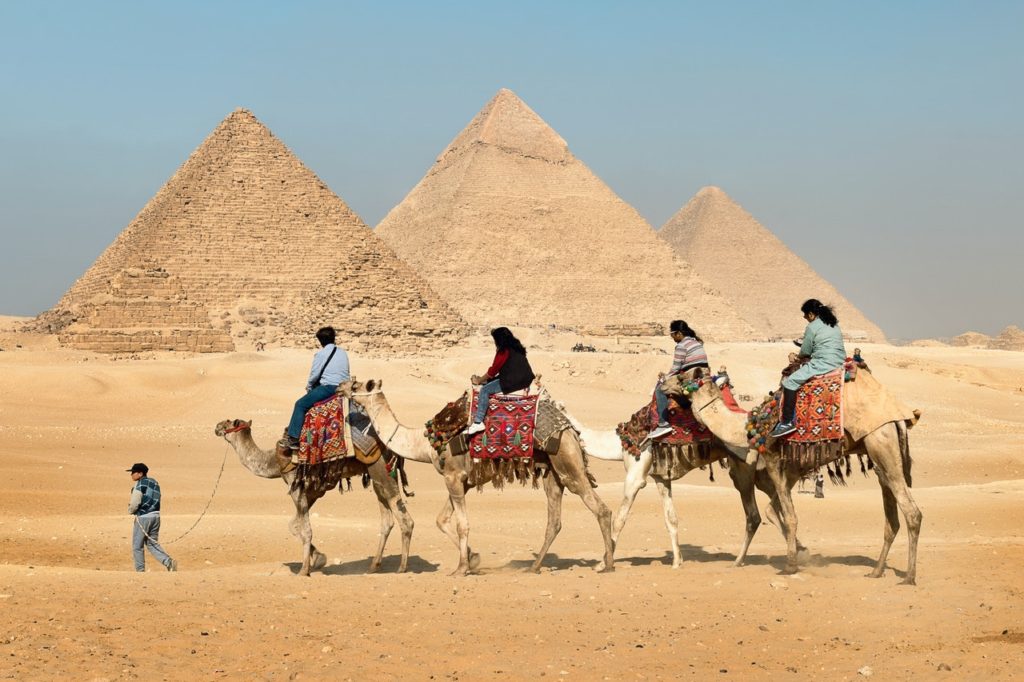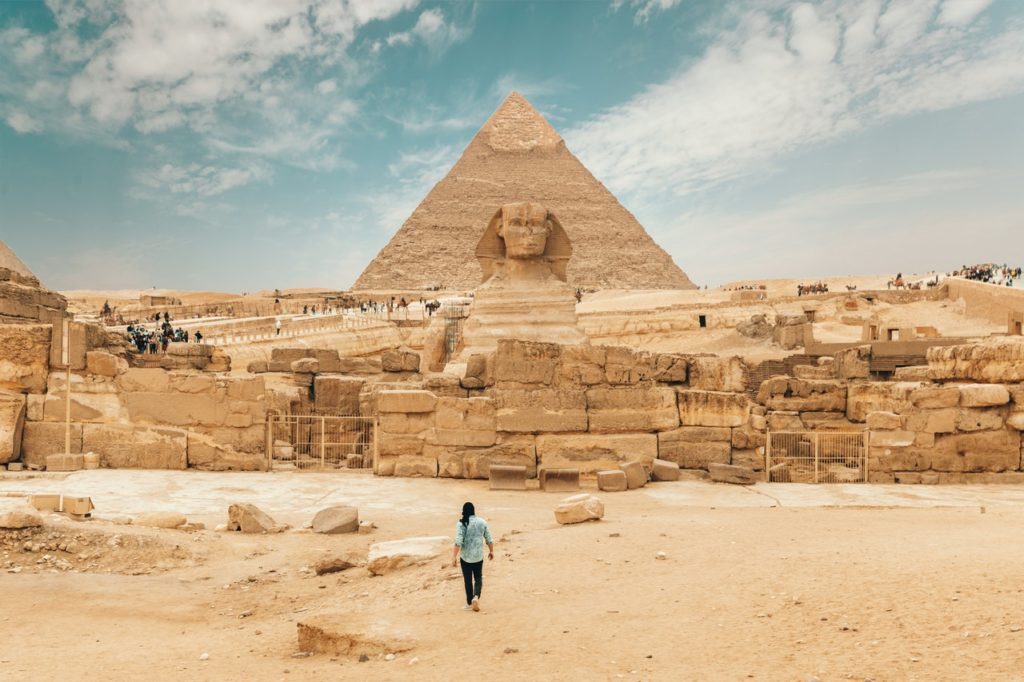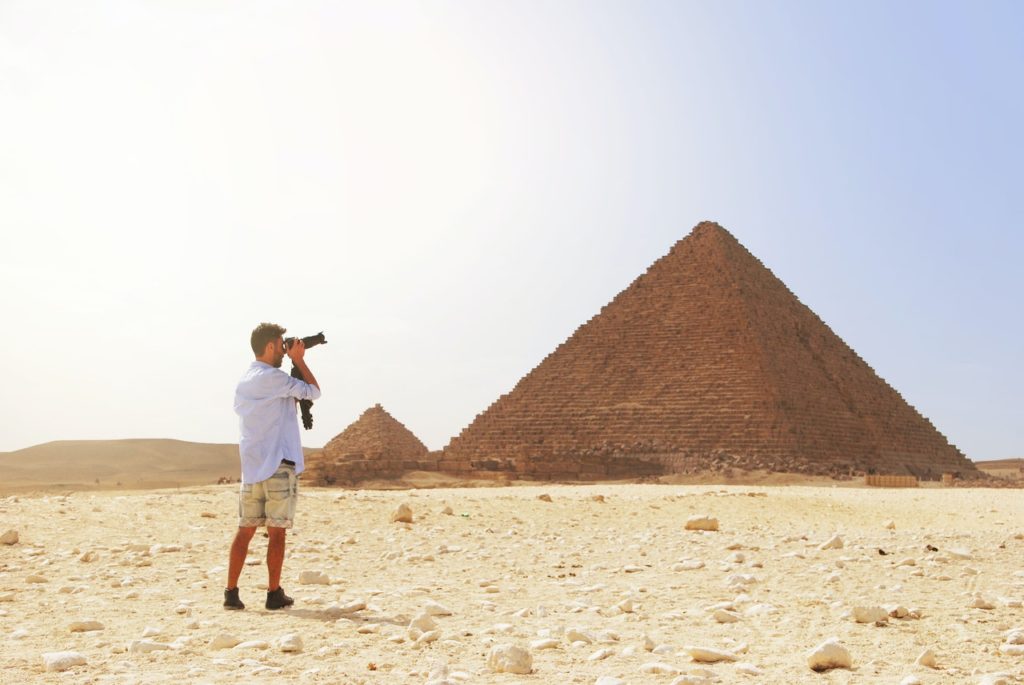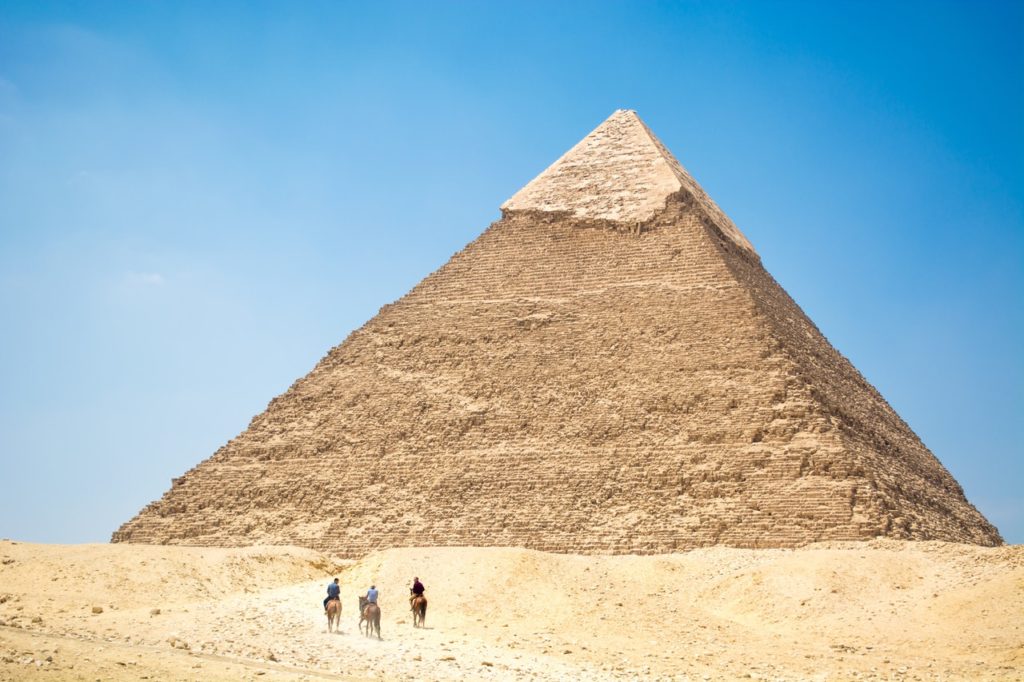The Great Pyramid is the last remaining of the 7 Wonders of the Ancient World. If you’re coming to Egypt, there’s a good chance you’re here to see it (and the other pyramids of Giza).

A camel ride is a quintessential part of your visit to the Pyramids of Egypt (Photo: Unsplash)
The Great Pyramid is the first and largest pyramid of the Giza pyramid complex, but that doesn’t mean the others aren’t incredibly impressive. There’s a lot to take in while you’re in Egypt—from pyramids to cemeteries to museums—and knowing the “lay of the land” will help you better plan your time.
If you’re wondering how to visit the Pyramids of Giza, this guide is here to break it down.
A Short History of the Pyramids of Giza
The Giza complex consists of three pyramids—each one is a tomb built for a prolific pharoah. The Great Pyramid was built around 2550 B.C. for King Khufu, and his son Khafre started the construction of his own pyramid about 30 years later. The Great Pyramid and the Pyramid of Khafre were the two largest pyramids built in ancient Egypt. (The legendary Sphinx was also built to watch over Khafre and is said to have been created to look like him.)
The last pyramid in the Giza complex is the Pyramid of Menkaure, dedicated to Khafre’s son (Khufu’s grandson) and built around 2490 BC. This is the smallest of the three pyramids, but there’s still plenty to admire about it. At 65 meters tall, it certainly isn’t “small.”
One of the most incredible things about the Pyramids of Giza is that nobody really knows exactly how they were built. Uncovering all the mysteries of the pyramids is an ongoing pursuit.
So, what do researchers know? Most researchers and scientists can agree that building the temples took up to 20,000 workers over the course of 20 years or so. And no, they weren’t slaves. Most of the workers were actually farmers who worked during a time when the Nile River flooded their land. There was even a temporary town set up nearby for them, complete with dwellings, shops, and other services.
The magnitude of work here is hard to grasp. To build the Great Pyramid, for example, more than 2.3 million blocks of stone were cut and transported to the site. Researchers believe an elaborate system of ramps was used to move the blocks of stone around but remain unsure of exactly how they functioned. Long story short: the ancient Egyptians were brilliant engineers, and their work remains shrouded in questions thousands of years later.
Fun Facts About the Pyramids of Giza
The pharaohs were buried with their most prized material possessions so that they had everything they needed to thrive in the afterlife. Sadly, many of these priceless treasures have been looted over the years.
The pyramids are almost perfectly aligned with the cardinal points, but researchers don’t have a concrete explanation for how it was done.
At least 130+ pyramids have been discovered around Egypt, but the ones at Giza are the most famous.
The pyramids were originally encased in white limestone and would have reflected the sunlight’s rays brilliantly, causing a sort of glimmer effect. That limestone has deteriorated over the years due to natural elements, but also because it was stripped for other building uses. You can see that the Pyramid of Khafre has some limestone remaining at its peak.
If you were to replicate these pyramids today (factoring in the cost of materials and labor), it’d cost about $1 billion to build all three!

There are many things to do at the Pyramids, including a visit to the world-famous Sphinx (Photo: Unsplash)
Things to Do at the Pyramids of Giza
There’s a lot to see and do at the Pyramids of Giza. Here are some of the best activities to enjoy:
Explore the Pyramids
Yes, you can venture into the pyramids, although each has its own entrance fee. You’ll likely feel dwarfed by these giants when you’re standing in their presence, so take some time outside the pyramids first to admire their size.
In the Great Pyramid, a small door leads through the Grand Gallery and into the King’s Chamber. There’s nothing here but an empty sarcophagus, but it’s impressive to be inside just the same.
You can also enter the two smaller tombs, but like the Great Pyramid, there’s not much to see inside. The crowds are definitely less congested, however, so if you want to roam around and imagine yourself back in the day of the ancient Egyptians, this is your chance.
See the Eastern and Western Cemeteries
Along the east side of the Pyramid of Khufu lie three smaller pyramids where Khufu’s wives and sisters were buried, as well as stone tombs in cemeteries used for officials and members of the royal family.
In the eastern cemetery, you can visit the mastaba (large tomb) belonging to Meresankh III, the wife of Khafre, to see its beautiful wall frescoes. The colorful scenes here all depict everyday, ordinary life. The mastaba for Seshemnufer IV doesn’t have the same impressive paintings, but the entryway has elaborate columns that are worth admiring.
At the royal cemetery, visit the Tomb of Senegemib-Inti to see its intricate wall carvings there.
Visit the Valley Temple
The Valley Temple of Khafre is a striking structure, made with granite blocks and alabaster flooring. The temple’s purpose was twofold: it was used for the mummification of the king, and also for the purification of the mummy before burial.
The mummification process is a fascinating one that would have taken 70 days to complete. High priests worked as embalmers to treat and wrap the body, all while performing the rites and prayers required at certain stages throughout. First, all internal organs would be removed immediately to prevent decay. Then they were placed in special jars to be eventually buried with the mummy.
To remove all moisture from the body, the priests used a type of salt known as natron which is known for its drying properties. When it came time for the wrapping, a priest would use several hundreds of yards of cloth to carefully bind the body. The Egyptians believed that the body was an important vessel for the spirit, and so they wanted to keep the body mostly intact to carry on in the afterlife.
See the Sphinx
This is easily one of the most recognizable monuments in Egypt—and the world. It’s carved out of granite and resembles a lounging lion, but with the head of the pharaoh (most researchers think it’s Khafre’s head) adorned with the royal headcloth. Nobody knows for certain what happened to the Sphinx’s missing nose.
Visit the Solar Boat Museum
Excavations around Giza in the mid-1900s led to the discovery of five long spaces for boats, including a Solar Barque (a vessel used by the sun god, Ra) broken into a thousand pieces and serving as an offering to the gods.
Incredibly careful restoration has pieced the boat back together, and now you can see the 4500-year-old vessel on display at the museum.

Visiting the Pyramids with a tour vs. solo (Photo: Unsplash)
Should You Visit the Pyramids With a Guided Tour?
While it’s possible to visit the pyramids on your own, this is the kind of experience you’ll really want to do on a guided tour. This is especially true if you’re only visiting Giza for a short amount of time and would prefer to soak up as much of the experience as possible, all while learning about this incredible place (and all the mysteries still surrounding it).
You’ve probably heard about the incredible crush of vendors all around the Giza complex who will try to sell you something you don’t want. This isn’t the case for all of them, of course, but it’s better to have something arranged beforehand if you want to avoid being overwhelmed. These vendors are only doing their jobs, but it’s better to go with a guide you trust than someone you’ve just met five minutes ago at Giza.
With the right tour, you won’t get a boring old spiel of memorized facts and history, either. Take the time to find a tour that really matches your interests. Here are some examples from Get Your Guide:
You can explore at a leisurely, relaxed pace on a Pyramids of Giza and Great Sphinx: Private Half-Day Tour. That means you won’t be jostled around on a tour bus with 100 other people.
If you’re a solo female traveler, you can join a female-led private tour of the pyramids, as well as an Egyptian Museum and a nighttime bazaar trip. Egypt can be challenging for women (especially those traveling alone), so a female-led is a great option for anyone who’s nervous about navigating the area.
Get a little adventurous on a Giza Pyramids Tour with Quad Bike Safari & Camel Ride (or take a shorter ATV trip into the desert if you just want a panoramic view of the pyramids and the Sphinx). A camel ride, in particular, is a quintessential thing to do at the Pyramids, at the very least for the epic photography.
Stick around later in the evening for the pyramids’ sound and light show. You’ll grab a seat at the Giza Plateau to watch the story of the Egyptians and their kings being projected onto the pyramids and the Sphinx.
Most tours also offer hotel pick-ups and transfers as well. For anyone who wants a certain level of convenience, a guided tour is the way to go. Everything is taken care of, and you can sit back and enjoy the experience.

A horse ride at the Pyramids of Giza (Photo: Unsplash)
Tips For Visiting the Pyramids of Giza
You should plan for a full day (5 hours at the very least) to explore the Pyramids of Giza. But if you want to take a glimpse inside every pyramid, cemetery, and museum, you’ll easily spend eight hours or more here. Keep in mind that there are restaurants and other facilities here should you need anything throughout the day (like a good meal).
You can visit the Pyramids of Giza year-round, but peak season is from December to February when temperatures are the coolest. (Be prepared for morning haze during this time, though. Sometimes it ruins photography.) The shoulder seasons (March to April, and October to November) are best for fewer crowds.
Remember: this is a desert environment, so it gets hot inside the pyramids and around the complex during the day. Cooler temperatures feel more welcoming, but crowds make things a little more uncomfortable. Outside of December to February, temperatures are a lot higher. Keep in mind that you’ll need to dress modestly when you visit, which makes it even warmer.
What does modest mean? Men are expected to wear long pants instead of shorts, but a t-shirt is fine. Women should not have their knees exposed, nor should they wear anything too revealing like a plunging neckline. Bare shoulders are also a no-no.
Be sure to pack sunscreen and carry lots of water. There’s very little relief from the sun and the heat in the middle of the desert! It’s also not a bad idea to pack a lunch rather than spend money on the inflated prices at the restaurants and cafes around the complex.
Arrive as early as possible. The earlier you’re there, the fewer crowds you’ll have to deal with. Anytime before 10 a.m. is a good time to beat the rush.
Also, if you can avoid the weekends, do so. Fridays and Saturdays are typically very busy as school is out and local families love to see the pyramids for themselves.
If you’d prefer to visit the Pyramids of Giza on your own, you can easily get an Uber. This is a good way to ensure you don’t get ripped off or scammed by overzealous taxi drivers. But for the best experience, a tour is the way to go.
***
Millions of people visit the Pyramids of Giza each year, and once you see them for yourself, it’s easy to understand why. There’s something incredibly humbling about standing at the bottom of the Great Pyramid and knowing that these larger-than-life monuments were created thousands of years ago without any of the technology we have today.
It’s a fascinating place and a trip of a lifetime. Enjoy every moment.